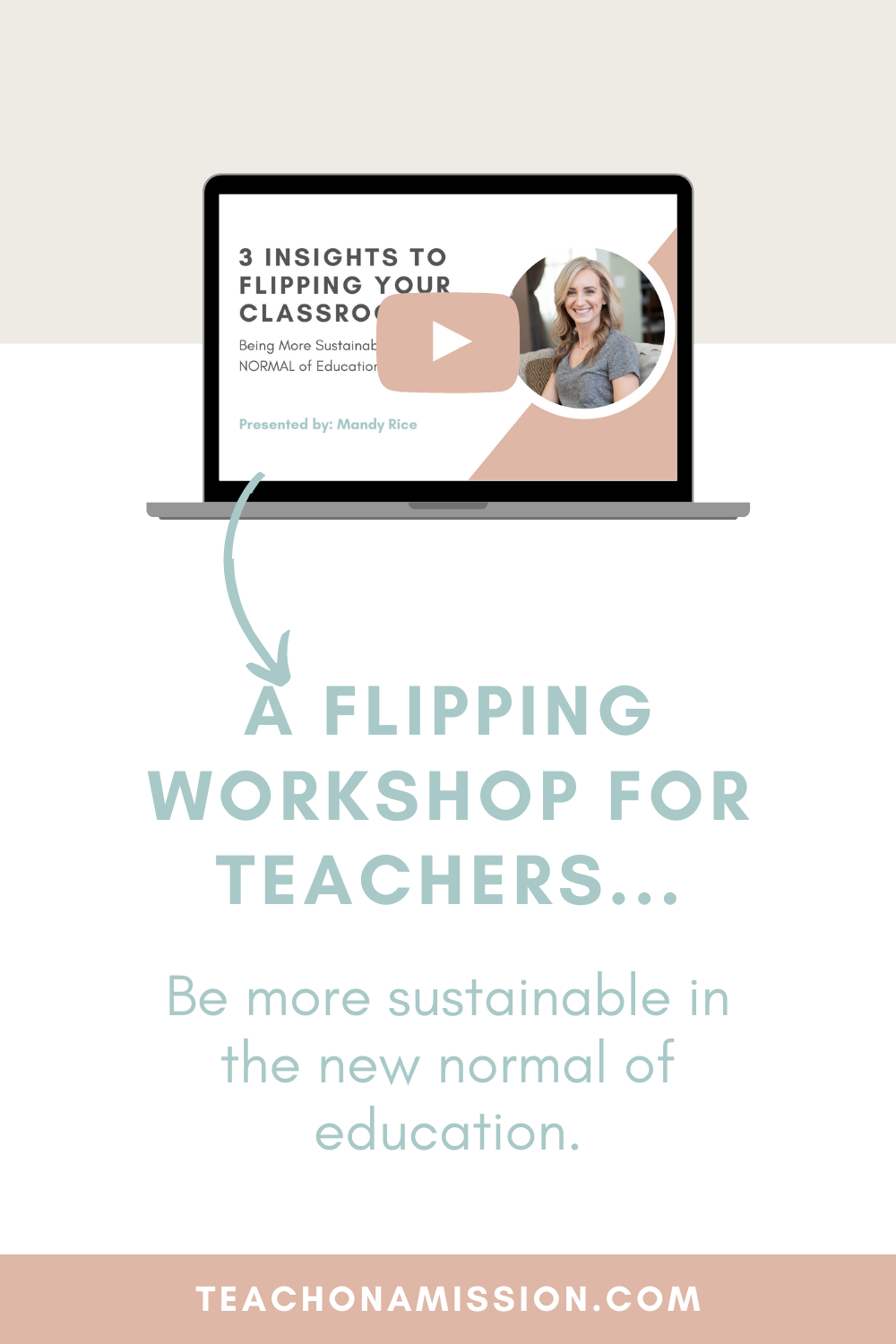Four-Step Reflection Process for Every Teacher
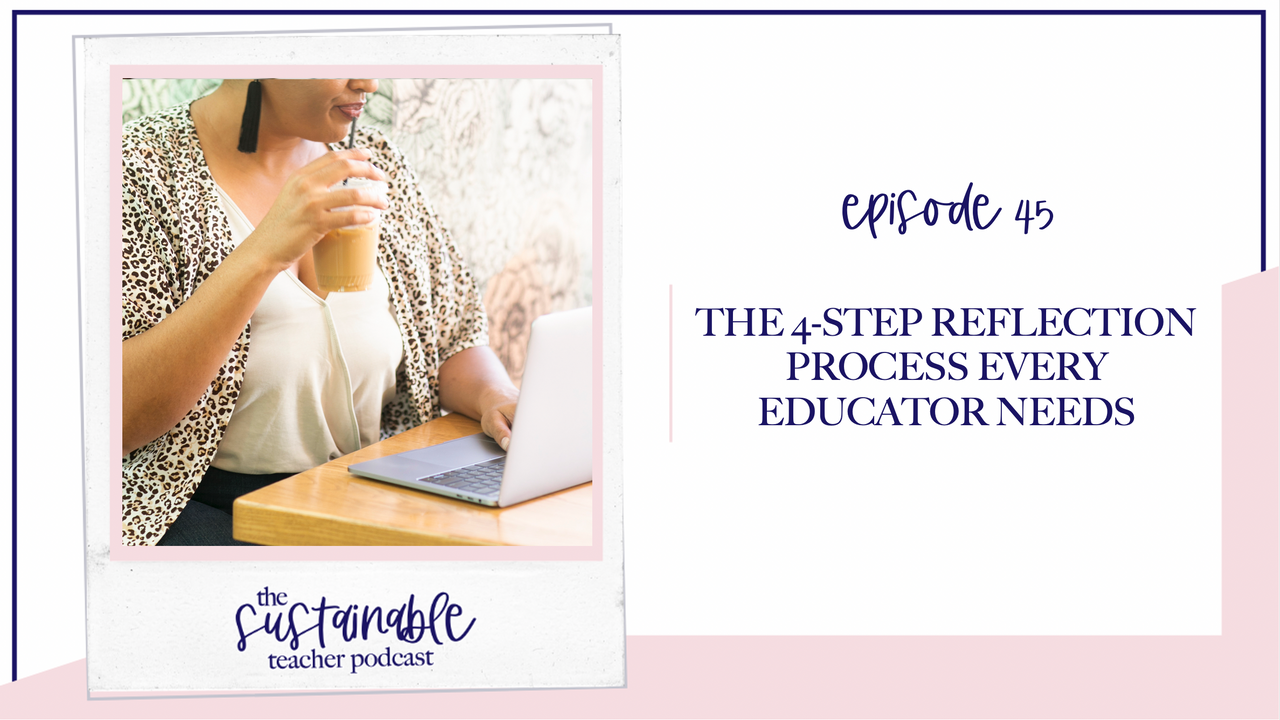
Well hey there, and welcome back to the Sustainable Teacher Podcast, I’m so glad you’ve decided to join me today for this four-step reflection process every educator needs, and I’ll just add that every teacher needs this if in fact they are feeling the pressure of all the change, and the overwhelm of seemingly never satisfying anyone whether it be parents, administration, or even our students. Now, I recognize that never is a dramatic word, but I’m betting it describes how you feel right now regardless of if it’s dramatic or not, so I’m sticking with it.
I was on a walk with my nine-month old puppy the other day, and when I’m on walks that’s when my wheels really get to turning, most of the time in good ways. Often I won’t even bring my headphones or listen to a podcast, although Ii’ve done that before, because the silence and the space for my mind to go where it wants leads me to some great ideas whether it be for this podcast, for teacher training, or for myself and my family. This story has nothing to do with this episode other than that the idea of this topic for today’s episode came from one such walk after a day of working with my preservice teachers in my Intro to Educational Technology class.
Having three classes of preservice teachers looking to me for guidance has very much got me thinking and prioritizing the advice I give so as to inspire but not overwhelm them, remain honest with them but not lead them to despair in what is a very hard career field to step into every day. One such piece of advice I wanted to give them the other day and that I will give to you today is that you are not always going to get it right. And that is ok.
And even when you do get it right, it’s not going to be perfect. Most of the time that doesn’t sit well with us educators because we value what we do so much. Oftentimes the pressure and burden we bear each day on getting things perfect is self-induced and it’s because we see the immense impact we can have, and we don’t want to get it wrong. This is the amazing thing about teaching, but also the most stressful in my opinion.
But if we are going to make it past the statistically deadly year five or heaven forbid all the way to retirement, we have to take a step back and recognize what’s really important and keep our focus on that.
And that’s what today’s episode is all about. After listening, you’ll have a four step reflection process that is NOT just about making sure you take the time to reflect on your practice (although, yes that is necessary), but that more importantly will help you keep what’s important, important.
We are teaching (and living) in a time where we are second guessing ourselves and everything we believe to be effective in our classrooms, and as much as I’m aware how much has changed, the basics of how the human brain learns, and how it does that best in a safe and welcoming environment surrounded by people they’ve emotionally connected with is still the same. So I hope these four steps help you confidently step back into the role as the number one influence on student learning in your classroom and help you prioritize exactly what is important about what you do.
Let’s get to it.
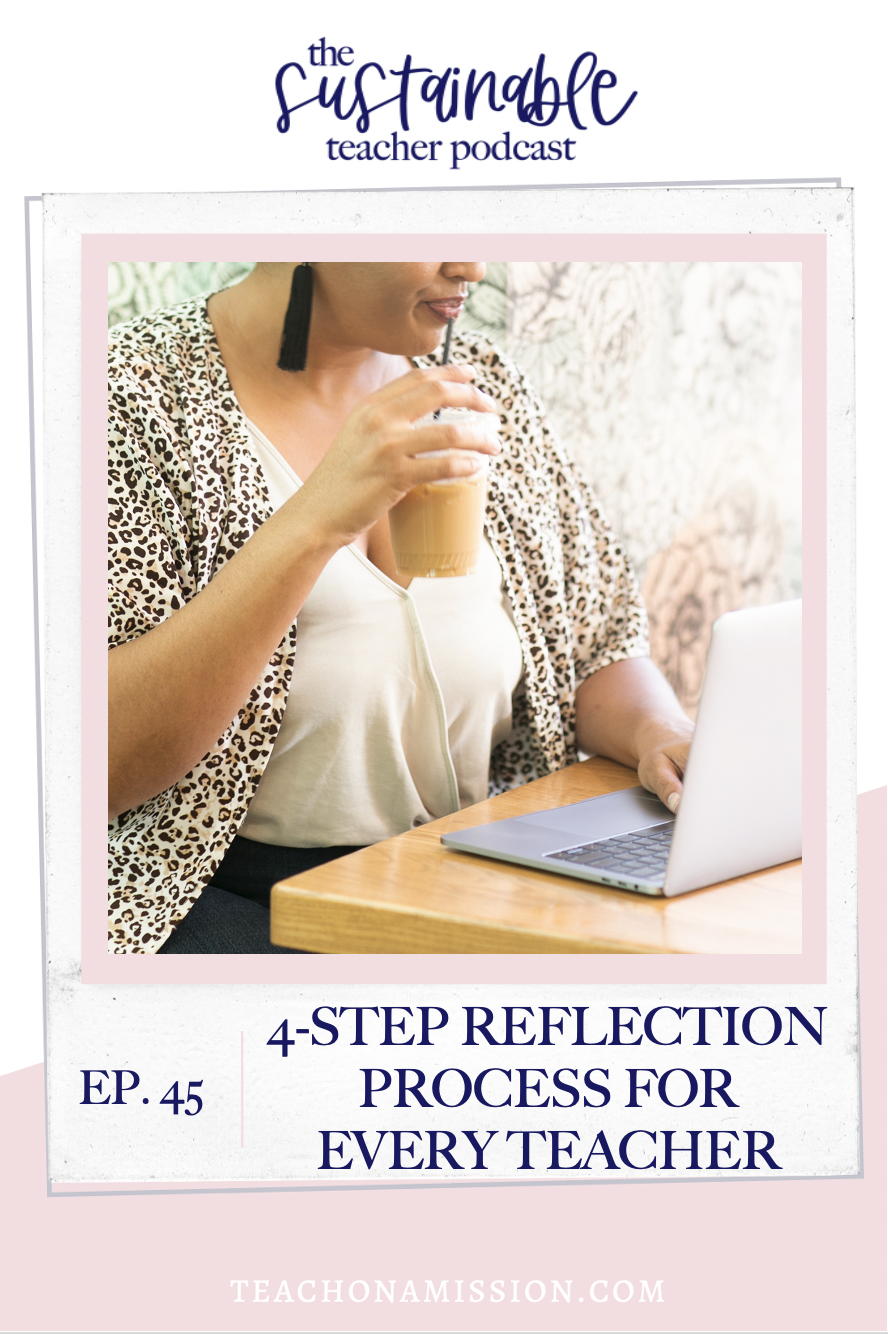
Alrighty, teacher-friend, let’s get right into it here with step one, and I’ve already kind of given it away. Here it is.
Accept that You Won’t Always Get it Right
Whether it be in your lesson plan format, your bell ringer or hook at the beginning of a lesson, how you handle classroom management, or even how you respond to a parent in any given situation, you will not always get it right.
As much as I’m saying this so that you’ll take a deep breath and take some of the pressure off your shoulders, I’m more so saying it here as step one in the reflection process so that you understand the significance of the reflection process itself. Because you won’t always get it right, you have to have a reflection process you follow that forces you to objectively look at how things are going, and improve upon it.
The key word is objectively. We wrap up a lot of emotion in what we do, because what we do is emotional, but if we live forever in those emotions we are only looking at our world through that subjective lens.
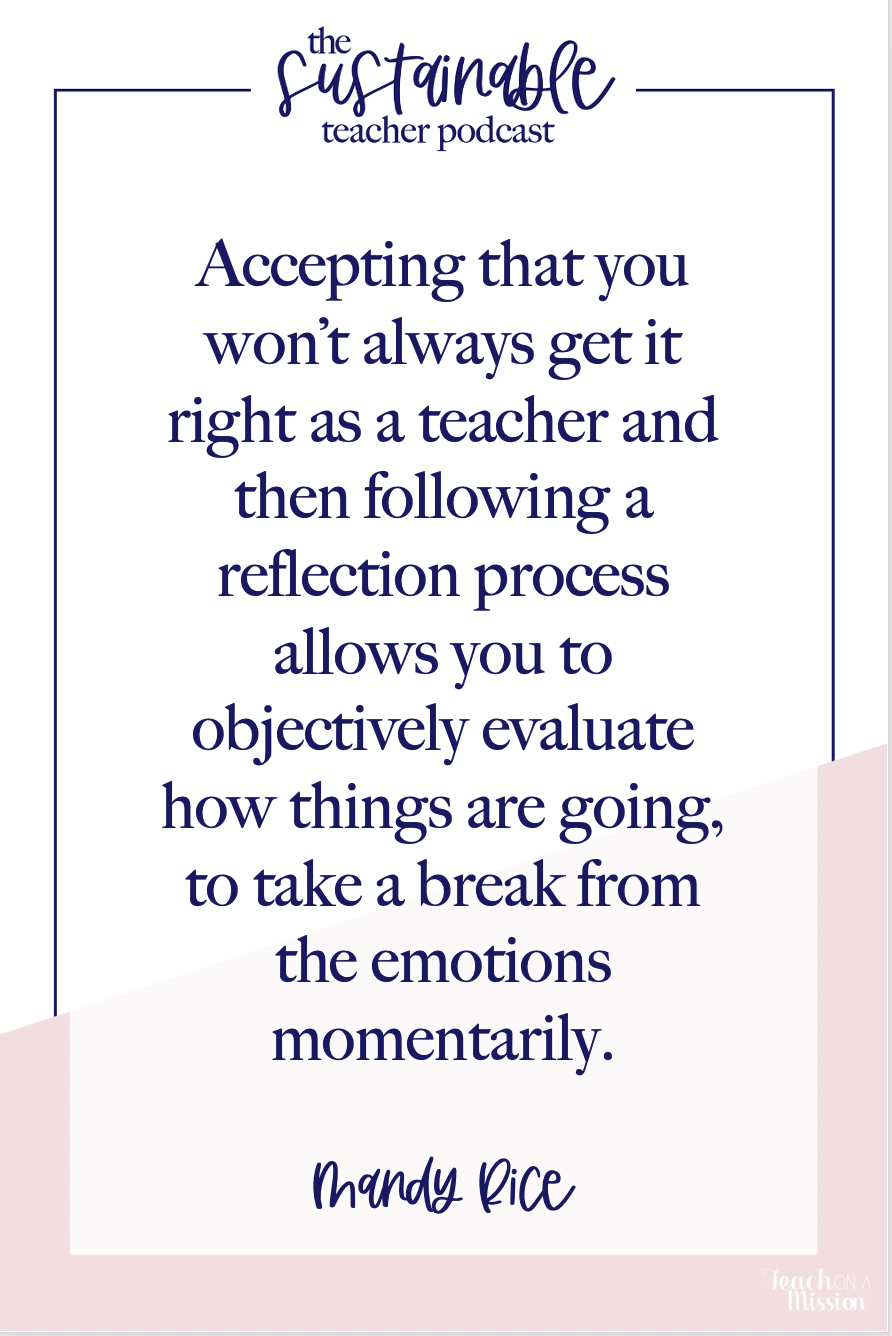
This four step process is a chance to step away from the emotions, look at how things have been going as objectively as possible, and take steps towards improvement.
Purpose
Which leads us to step two.
Have a full understanding of the purpose of everything your students do in your classroom. Whether it be the details of your lesson plans, each and every classroom procedure, how you arrange your desks, what you put on your classroom walls, how you respond to student questions or parent emails and phone calls, all of it. Ask yourself, what is its purpose or what is my intention with how I’m doing this.
If the purpose or your intention is not aligned with one of the following areas, then it isn’t important. Everything you do in your classroom should serve one of these purposes:
- Student mastery of content and metacognitive awareness of individual learning,
- Relationship building with students that allows for authentic connection, and
- Creating a welcoming and safe classroom environment where all are welcome and the messy learning process is celebrated.
If anyone listening today can think of another priority for your classroom outside of these three, please come join us in the Sustainable Teacher Podcast Facebook group, which is linked in the show notes, and please let me know. Truly, I want to have discussions with other educators, and want to know if I’m off base here with these priorities or may be missing something.
Back to the point though. If you’re evaluating a task, activity, or procedure of your classroom, or considering adding something to your classroom or a lesson, you must ask what its purpose is through these three filters.
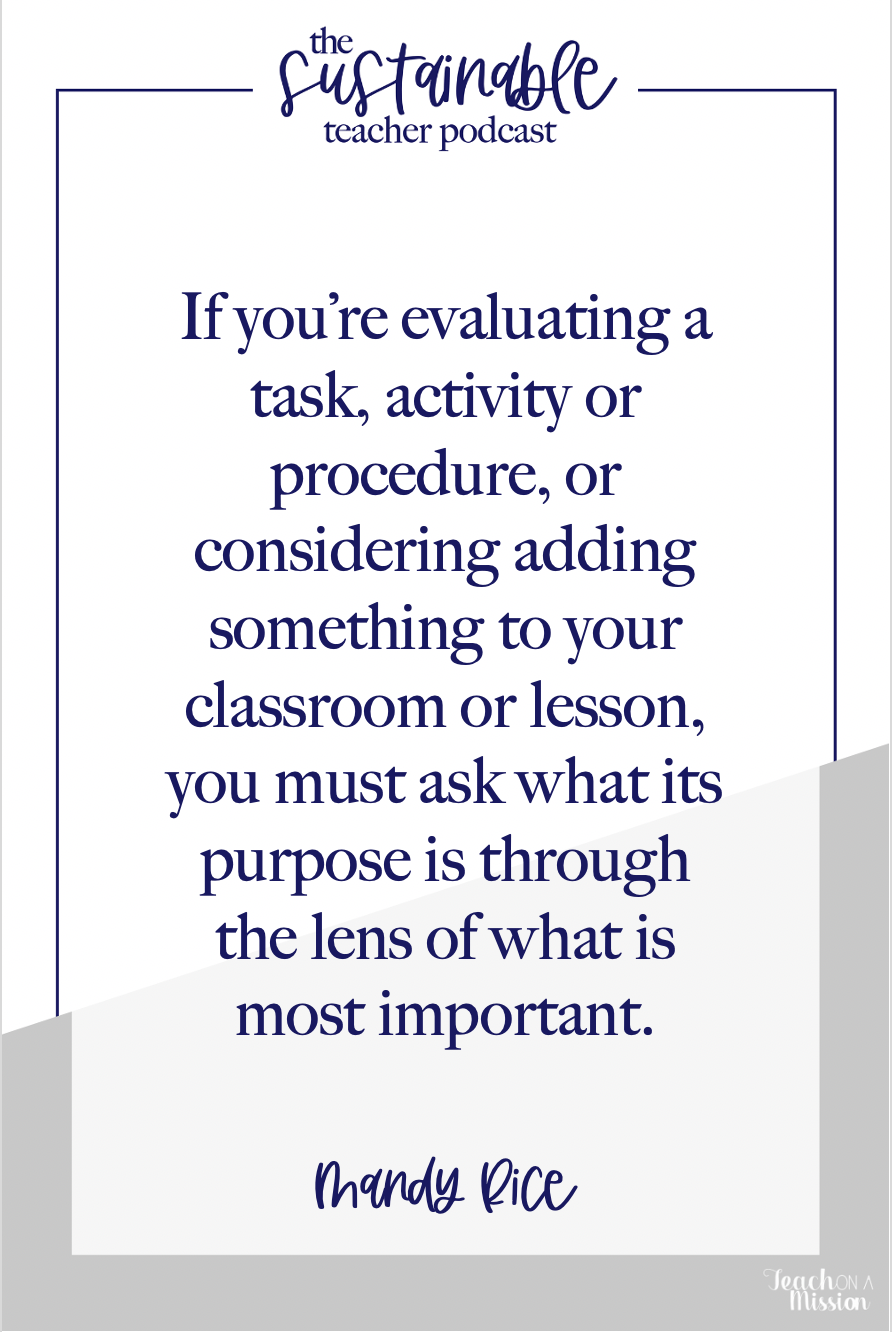
This step alone will help make sure that you’re keeping the most important things as the most important things in your classroom. I hope that as you’re listening you feel convicted about just one thing that you do in your classroom and how without a doubt you know you can eliminate it and feel freed by it’s elimination - it’s one less thing on your plate and one less thing to distract you and your students from what’s important.
Cost to Benefit Ratio
Step three in this four step reflection process is to analyze the cost to benefit ratio for YOU, but also for your students. Meaning, how much will it cost you and your students for you or your students to receive the benefit on the other end?
Oftentimes it’s easy to breeze over this step in the reflection process all in the name of “what’s best for students.” I would argue that many teachers have sacrificed quite a lot in the name of what’s best for their students. And although, of course, we should consider what’s best for students, it would be unwise to assume the most arduous route is the best one. We can do what’s best for them and preserve our own well-being in the process.
This is a realization I had difficulty coming to in my years in the classroom. I almost wore it like a badge of honor when I had to work way harder than my students in order for them to benefit from a lesson, master a standard, or somehow come out on top.
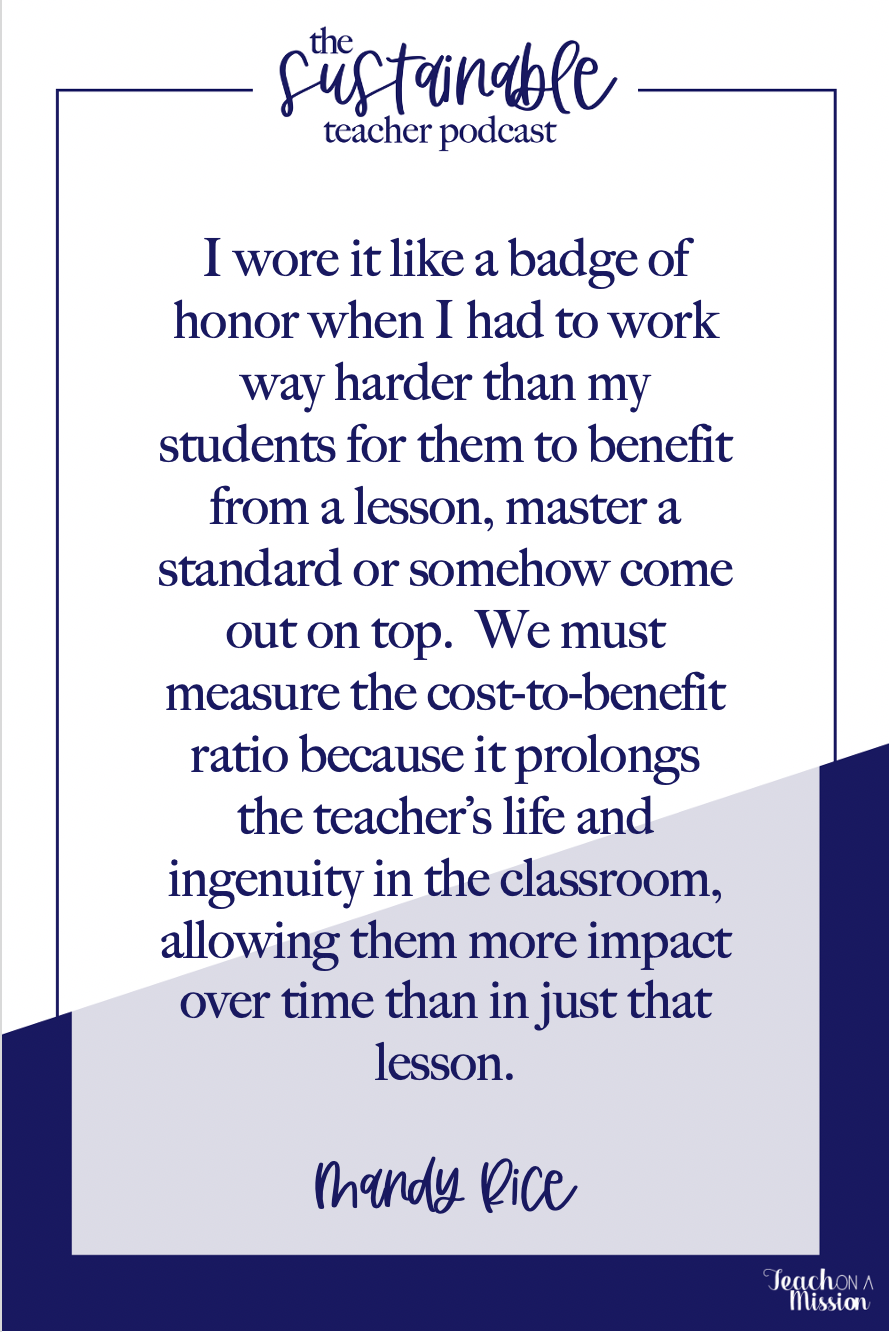
And the same goes for our students. If a project takes a student two weeks to complete and it only challenges them to master one standard or understand a small amount of content compared to what’s necessary for the entire unit, then that’s not an effective use of that student’s time who has other subjects they are working hard in as well. I would even challenge teachers listening to consider if the time you have in class plus the time you require for homework is TRULY, absolutely necessary in order for your students to master your content.
I would argue that in most cases, students performing at their grade level do not need to dedicate that much time to school. Students who are performing under grade level and need to catch up, sure, that extra time is crucial. But let’s all stop acting like school is the only important thing in a student’s life or that school is the only way that kids will ever learn anything in life.
Don’t get me wrong, teachers have immense impact - of course they do, I’ve lived it, and know it in my bones. But in order to prolong our effective teachers and to keep our kids motivated in school longer, please, analyze the cost to benefit ratio for all aspects of your classroom, for both you and your students.
This episode is brought to you by...
This episode of the Sustainable Teacher is sponsored by my tried and true, free online masterclass, “Three Insights to the Flipping Your Classroom: How to Be More Sustainable in the Post-Pandemic Classroom”. After spending 10 years flipping my classroom and helping teachers in my district and state do the same, I decided to put my experience and guidance into an online training that will help you go from drowning in working harder than your students to a flipped classroom that empowers your students in your content. When you’re ready to say yes to a more sustainable classroom and join thousands of other teachers who I’ve helped do the same, head to teachonamisision.com/fliippingwebinar to learn more and get enrolled now.
Rinse and Repeat
Step four in this reflection step takes us back to step one and is to again remember that you will NOT always get it right. The process is cyclical for a couple of reasons. First, so that you always, until the end of your career, are considering how to improve and make it better for you and your students, and not just in a “I have to make all my lessons huge, amazing, and wonderful all of the time.” NO, not that. More so, analyze how to make it more effective and sustainable for all.
Secondly, and this is what I mentioned at the beginning of the episode, take a deep breath teacher friend. Take a load of pressure off your shoulders and know that you won’t always get it right, but if you follow this reflection process and work hard to keep what’s important and the most important, then you’re less likely to get it wrong. You’re more likely to keep priorities that sustain you and keep your classroom effective for your students.
Teacher Reflection Process Recap
And there you have it, teacher-friend. The four-step reflection process to help you keep what’s important, important, but in a way that sustains you and is effective for your students. Let’s do a recap of the steps, and then I have one more tidbit of advice for you. In a quick summary, here are the four steps of reflection.
- Know that you’re not always going to get it right so be sure and follow the next three steps.
- Have a full understanding of the purpose for all things in your classroom whether it be student-mastery or relationship building, etc.
- Analyze the cost-to-benefit ratio for you especially but also for your students. Don’t assign your students something that’s going to take a really long time but have very little benefit. Same goes for how long it takes you to prep and grade.
- Remember again that even going through the steps you’re not always going to get it right so be sure and reflect afterwards on everything you’ve done analyzing how it went and what you should change.
When Should a Teacher Reflect?
Now you may be asking when should I go through this reflection process, and what kind of episode would this be if I didn’t chat when to implement the steps. So here goes.
These four steps don’t have to be a linear, get-it-down-on-paper, super formal affair every-time you need to reflect. They could simply be a couple questions you ask yourself every time you’re at a team meeting or whenever you sit down to plan. So don’t think you aren’t reflecting if you don’t do it in a formal way. I would encourage you to have a section in your unit or lesson plans where you can jot down notes of reflection as you have them - that’s just good practice.
But WHEN? I personally like to be proactive in my reflection. Which I guess then doesn't make it “reflection”, as in looking back, now does it? But to start out, I would encourage you to think back on a lesson you've done recently, or a classroom procedure you currently have, and run it through the ringer with this reflection process. Come to some concrete conclusions, and then do it again with another lesson or procedure.
Go through the reflection process a couple of times so you can get used to it, get good at it, then start implementing them proactively as well as after the fact. When you’re at a team meeting planning for the next unit, when you’re considering how best to prepare students for XYZ, always know the purpose and the cost-to-benefit ratio.
Thanks so much for listening today, teacher-friend. For a full text version of today's episode and any pertinent links, please head to our website linked below for the episode’s full show notes. And don’t forget to join us in our Facebook community to keep this conversation going.
I’ll see you there, and I’ll see you here, same time, same place next week. Bye for now.

P.S. Want to flip your classroom before Winter Break this year??? As in, you'll do the organizing, the prep work now, then be ready to implement your fully flipped classroom in second semester. Now is the time to start so you AREN'T scrambling at the last minute. I am inviting you to my completely free, at your own pace professional development workshop that will take about one hour, is online, and will give you the guidance and direction you need to get started flipping your classroom today. Click here to choose a time that works best for you, and I'll send you a completion certificate when it's over. I'll see you there.

